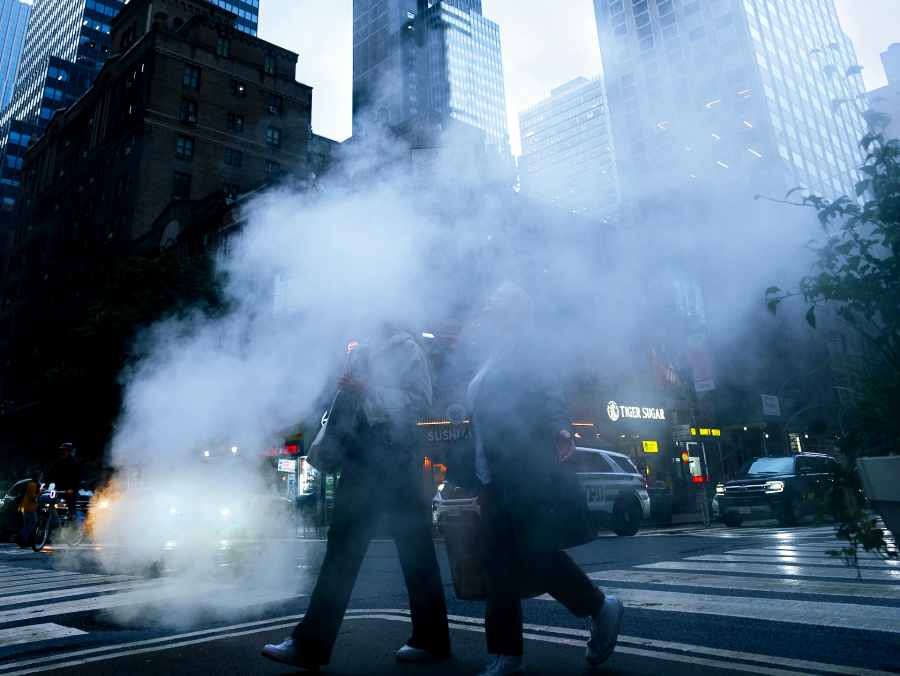Sun 14 April 2024:
In 2023, Bangladesh recorded the worst air quality of 134 countries monitored by the Swiss climate group, IQAir. Pakistan and India were close behind, with the report showing that South Asia suffers from the worst pollution in the world overall.
Here are some insights from the report and what it tells us about the South Asian countries’ governments.
What does the 2023 World Air Quality Report say?
The report provides an overview of PM2.5 air quality data from 7,812 cities across the world. PM2.5 refers to fine particulate matter which is 2.5 microns or smaller in diametre and is dangerous because it can pass deep into the human respiratory tract. These particles are released during natural events such as dust storms and wildfires, or can be caused by human activities such as coal burning or agricultural work.
According to World Health Organization (WHO) guidelines, average annual levels of PM2.5 should not surpass 5 micrograms per cubic metre. Only 10 countries listed in the report comply with this standard, however. They include French Polynesia – which has the cleanest air in the world according to the report – New Zealand, Finland and Estonia, among others.
Bangladesh’s PM2.5 levels stand at 79.9 micrograms per cubic metre, nearly 16 times higher than the WHO recommends. Pakistan scored 73.7 while India’s air had 54.4 micrograms of PM2.5 particles per cubic metre on average over the last year.
How do South Asian cities rank in terms of air quality?
Within each of the countries monitored by IQAir, air quality can vary hugely from city to city.
Begusarai, the industrial and financial capital of India’s Bihar, with refineries and power stations, had a whopping 118.9 micrograms of PM2.5 particles per cubic metre on average in 2023. New Delhi had 92.7, while Dhaka in Bangladesh had 80.2 and Pakistan’s smog-ridden Lahore recorded an average of 99.5.
According to the IQAir report, this compares with San Juan in Puerto Rico, the least polluted city in the world, with only 2.7 micrograms of PM2.5 particles per cubic metre on average in 2023. Wellington in New Zealand comes second, with 3.1 micrograms and Canberra in Australia has 3.8 micrograms.
Why is the air quality in South Asian cities so poor?
The report found that poor air quality in South Asia is often down to “brick kiln and other industrial emissions, agricultural waste burning, and cremation practices”. It added that the burning of solid fuel for cooking and heating, especially during colder months, adds to the air pollution.
In Bangladesh, there are an estimated 8,000 brick kilns, some of which operate illegally. Plastic rubbish incineration and vehicle fumes also contribute to the deteriorating air quality. During crop burning season, smoke from India, Nepal and Pakistan can also drift into Bangladesh.
Northern India and Delhi have particularly poor air quality because of biomass burning – or the burning of wood or crop wastes to make fuel, coal burning and vehicle emissions. Annual crop burning – whereby farmers in India and Pakistan burn plant residue after harvesting rice to prepare the fields for wheat plantation – is also a contributor to air pollution.
What is the effect of poor air in Asia?
The Environmental Research Group at Imperial College London published a review in April 2023 following decades of scientific research about air pollution.
The review found connections between air pollution and the health of newborn babies in the first weeks of life, low birth weight, miscarriages and stillbirths. It also found that early exposure to air pollution can hinder development.
According to the Air Quality Life Index (AQLI) published by the Energy Policy Institute at the University of Chicago (EPIC) in August 2023, the average Indian’s life expectancy is reduced by 5.3 years due to PM2.5 pollution. In New Delhi, life expectancy is cut by 10 years.
The report found that an average Pakistani would live for 3.9 years longer if air quality met the WHO guidelines.

Besides the health effects, air pollution in Pakistan and India affects everyday activities such as education and business.
In early November 2023, Pakistan’s Punjab province, engulfed in a blanket of smog, declared an emergency in Lahore, Gujranwala and Hafizabad and all public places were closed. In Delhi, India’s capital territory, schools were closed and construction was halted due to dangerous levels of air pollution at the same time. Later in November 2023, face masks were made mandatory in Lahore.
What can be done to remedy South Asia’s air quality crisis?
The IQAir report recommends that governments invest in renewable energy initiatives, introduce incentives for cleaner vehicles, improve infrastructure to enable better pedestrian mobility and ban agricultural burning practices.
The report particularly highlighted a lack of government-operated air quality monitoring stations in South Asia. Some 96 percent of stations reporting air quality data in Lahore and Peshawar in Pakistan, as well as Dhaka in Bangladesh, were not affiliated with the countries’ governments.
The IQAir report concluded that while this shows that private residents and organisations want to document and monitor air pollution levels, governments are not taking responsibility for doing so.
Some attempts have been made by South Asian governments to curb air pollution. Coal burning was banned in Delhi’s National Capital Region (NCR) in January 2023, for example.
Older vehicles were banned in Delhi in 2018, resulting in a 35 percent decrease in the number of cars on the road, according to the IQAir report. However, in November 2023, a collaborative project between the Delhi government and the Indian Institute Of Technology Kanpur showed that vehicle emissions remained the largest contributor to air pollution in the city.
India and Pakistan have turned to cloud seeding to prompt artificial rain in order to curb smog. Cloud seeding is a weather modification technique that uses ground-based generators or aircraft to allow clouds to be modified with a compound to form ice crystals that facilitate the formation of rainwater droplets.
The caretaker minister for the environment in Pakistan’s Punjab, Bilal Afzal, told the Guardian that cloud seeding carried out in Lahore had been a success. While air quality in Lahore had improved with a small amount of rain, however, it did not last for more than a few days as the air pollution went back to its usual levels afterwards.
The Ministry of Environment, Forest and Climate Change in Bangladesh announced in January that it intends to use a brick kiln tracker, which will use remote sensing technology to identify harmful brick kilns and to help improve enforcement.
SOURCE:AL JAZEERA
______________________________________________________________
FOLLOW INDEPENDENT PRESS:
WhatsApp CHANNEL
https://whatsapp.com/channel/0029VaAtNxX8fewmiFmN7N22
![]()
TWITTER (CLICK HERE)
https://twitter.com/IpIndependent
FACEBOOK (CLICK HERE)
https://web.facebook.com/ipindependent
YOUTUBE (CLICK HERE)
https://www.youtube.com/@ipindependent
Think your friends would be interested? Share this story!





